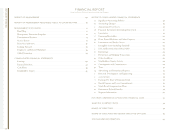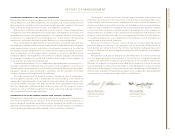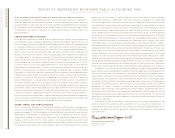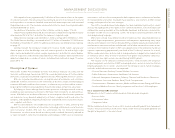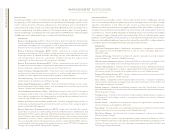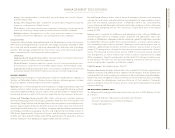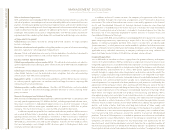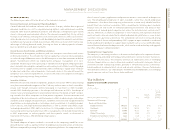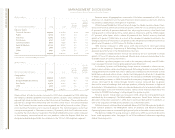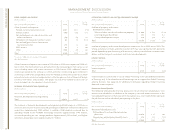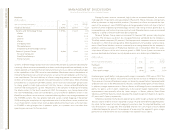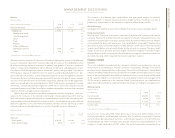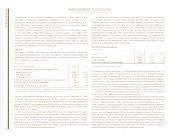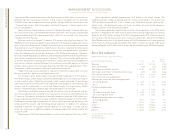IBM 2004 Annual Report Download - page 18
Download and view the complete annual report
Please find page 18 of the 2004 IBM annual report below. You can navigate through the pages in the report by either clicking on the pages listed below, or by using the keyword search tool below to find specific information within the annual report.
MANAGEMENT DISCUSSION
International Business Machines Corporation and Subsidiary Companies
16
ibm annual report 2004
Sales & Distribution Organization
With a comprehensive knowledge of IBM’s business and infrastructure solutions, as well as the
individual products, technologies and services offered by IBM and its network of business
partners, the company’s global team of account representatives and solutions professionals
gain a deep understanding of each client’s organizational, infrastructure and industry-specific
needs to determine the best approach for addressing the client’s critical business and IT
challenges. These professionals work in integrated teams with IBM consultants and technol-
ogy representatives, combining their deep skills and expertise to deliver high-value solutions.
INTERNAL ROUTES-TO-MARKET
Global Services consultants focused on selling end-to-end solutions for large, complex
business challenges.
Hardware and software brand specialists selling IBM products as parts of discrete technology
decisions, typically to “self-integrating” IT departments.
ibm.com Online and telephone sales and assistance operations handle basic commodity
transactions for large enterprises and small-to-medium businesses.
BUSINESS PARTNERS ROUTES-TO-MARKET
Global/major independent software vendors (ISVs). ISVs deliver business process or industry-
specific applications and, in doing so, often influence the sale of IBM hardware, middleware
and services.
Global/major systems integrators (SIs). SIs identify business problems and design solutions
when Global Services is not the preferred systems integrator; they also sell computing
infrastructures from IBM and its competitors.
Regional ISVs and SIs. SIs identify the business problems, and ISVs deliver business process
or industry-specific applications to medium-sized and large businesses requiring IBM
computing infrastructure offerings.
Solutions providers, resellers and distributors. Resellers sell IBM platforms and value-added
services as part of a discrete technology platform decision to clients wanting third-
party assistance.
Research, Development and Intellectual Property
IBM’s research and development (R&D) operations differentiate IBM from its competitors. IBM
annually spends approximately $5– 6 billion for R&D, including capitalized software costs,
focusing its investments in high-growth opportunities. As a result of innovations in these
and other areas, IBM was once again awarded more U.S. patents in 2004 than any other
company. This marks the 12th year in a row that IBM achieved this distinction.
In addition to producing world-class hardware and software products, IBM innovations
are a major differentiator in providing solutions for the company’s clients through its
growing services activities. The company’s investments in R&D also result in intellectual
property (IP) income. Some of IBM’s technological breakthroughs are used exclusively in
IBM products, while others are used by the company’s licensees for their products when
that new technology is not strategic to IBM’s business goals. A third group is both used
internally and licensed externally.
In addition to these IP income sources, the company also generates value from its
patent portfolio through cross-licensing arrangements and IP licensed in divestiture
transactions. The value of these other two sources is not readily apparent in the financial
results and Consolidated Statement of Earnings, because income on cross-licensing
arrangements is recorded only to the extent that cash is received. The value received by
IBM for IP involving the sale of a business is included in the overall gain or loss from the
divestiture, not in the separately displayed IP income amounts in financial results and
Consolidated Statement of Earnings.
In January 2005, IBM announced that it would pledge 500 of its patents for use by the
open computing community, representing a major shift in the way IBM manages and
deploys its intellectual property portfolio. IBM’s intent is to help form an industry-wide
“patent commons,” in which patents are used to establish a platform for further innovation
in areas of broad interest to information technology developers and users. The pledge is
applicable to any individual, community or company working on or using software that
meets the Open Source Initiative (OSI) definition of open source software.
Integrated Supply Chain
Just as IBM works to transform its clients’ supply chains for greater efficiency and respon-
siveness to market conditions, IBM has undertaken a large-scale initiative to recast its own
integrated supply chain as an on demand business operation, turning what had previously
been an expense to be managed into a strategic advantage for the company and, ultimately,
improved delivery and outcomes for its clients. IBM spends approximately $41 billion
annually through its supply chain, procuring materials and services around the world. The
company’s supply, manufacturing and distribution operations are integrated in one oper-
ating unit that has reduced inventories, improved response to marketplace opportunities
and external risks and converted fixed to variable costs. Simplifying and streamlining
internal operations has improved sales force productivity and processes and thereby the
experiences of the company’s clients when working with IBM. Because some of the cost
savings this unit generates are passed along to clients, they will not always result in a visible
gross margin improvement in the company’s Consolidated Statement of Earnings. While
these efforts are largely concerned with product manufacturing and delivery, IBM is
also applying supply chain principles to service delivery across its solutions and services
lines of business. To accomplish this, IBM is creating a new labor resource management
system— based on a uniform taxonomy of skills —that will enable the organization to more
efficiently match its labor resources to the needs of IBM clients, deploy the right expertise
quickly, and create a better short-term and long-term balance of labor supply and
demand by comparing the demands of the market against the database of available skills.
In addition to its own manufacturing operations, the company uses a number of con-
tract manufacturing (CM) companies around the world to manufacture IBM-designed
products. The use of CM companies is intended to generate cost efficiencies and reduce
time-to-market for certain IBM products. Some of the company’s relationships with CM
companies are exclusive. The company has key relationships with Sanmina-SCI for the
manufacture of some Intel-based products and with Solectron for a significant portion of
the manufacturing operations of Global Asset Recovery Services— an operation of Global
Financing that restores end-of-lease personal computers and other IT equipment for resale.




